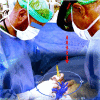Value of the surgeon's sightline on hologram registration and targeting in mixed reality
- PMID: 32984934
- PMCID: PMC7671978
- DOI: 10.1007/s11548-020-02263-3
Value of the surgeon's sightline on hologram registration and targeting in mixed reality
Abstract
Purpose: Mixed reality (MR) is being evaluated as a visual tool for surgical navigation. Current literature presents unclear results on intraoperative accuracy using the Microsoft HoloLens 1®. This study aims to assess the impact of the surgeon's sightline in an inside-out marker-based MR navigation system for open surgery.
Methods: Surgeons at Akershus University Hospital tested this system. A custom-made phantom was used, containing 18 wire target crosses within its inner walls. A CT scan was obtained in order to segment all wire targets into a single 3D-model (hologram). An in-house software application (CTrue), developed for the Microsoft HoloLens 1, uploaded 3D-models and automatically registered the 3D-model with the phantom. Based on the surgeon's sightline while registering and targeting (free sightline /F/or a strictly perpendicular sightline /P/), 4 scenarios were developed (FF-PF-FP-PP). Target error distance (TED) was obtained in three different working axes-(XYZ).
Results: Six surgeons (5 males, age 29-62) were enrolled. A total of 864 measurements were collected in 4 scenarios, twice. Scenario PP showed the smallest TED in XYZ-axes mean = 2.98 mm ± SD 1.33; 2.28 mm ± SD 1.45; 2.78 mm ± SD 1.91, respectively. Scenario FF showed the largest TED in XYZ-axes with mean = 10.03 mm ± SD 3.19; 6.36 mm ± SD 3.36; 16.11 mm ± SD 8.91, respectively. Multiple comparison tests, grouped in scenarios and axes, showed that the majority of scenario comparisons had significantly different TED values (p < 0.05). Y-axis always presented the smallest TED regardless of scenario tested.
Conclusion: A strictly perpendicular working sightline in relation to the 3D-model achieves the best accuracy results. Shortcomings in this technology, as an intraoperative visual cue, can be overcome by sightline correction. Incidentally, this is the preferred working angle for open surgery.
Keywords: 3D modeling; Augmented reality; Colorectal surgery; Computer-assisted surgery; Image-guided surgery; Three-dimensional imaging.
Conflict of interest statement
Opinions, interpretations, conclusions and recommendations are those of the author and are not necessarily endorsed by the funders. Dr. Luzon, Dr. Stimec, Dr. Bakka, Dr. Edwin and Dr. Ignjatovic have no conflicts of interest to declare with respect to the research, authorship and publication of this article.
Figures






References
MeSH terms
Grants and funding
LinkOut - more resources
Full Text Sources
Miscellaneous

